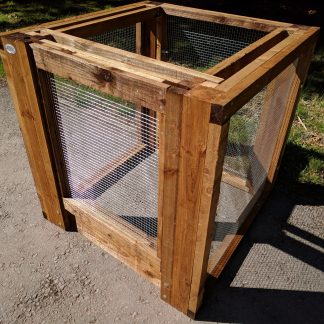We’ve divided the Composting Process into 3 areas:
- 7 Steps
- 3 Stages
- 2 Indicators
Composting can be considered as little more than waste material management. However, the finished product can have huge benefits for the environment. Good quality compost is produced by following seven simple Steps. Consider
compost making in terms of following a recipe for making a cake. The better the Steps are adhered to, the better the cake.
Composting will happen of its own accord without any intervention. Visit any wood and various stages of the biological process will be on view. These range from uncomposted leaves, semi-rotted material to dark rich crumbly damp soil. The end result of the composting process.
The 7 Composting Steps
- Start with ‘green’ waste. (material high in nitrogen such as grass, animal manure, green leaf weeds etc.)
- Add ‘brown’ waste (material high in carbon, such as shrub prunings, a few brown leaves, straw, crunched up paper, etc.
- Shred/chip and mix the greens with the browns.
- Add micro-organisms to speed up the process, such as Garotta.
- Insulate and protect the heat produced by the composting process.
- Control the moisture content and add water if necessary.
- Maintain air flow as necessary, too much and the material dries out. Too little and its stays wet and soggy for too long.
The 3 Stages of Composting
Stage 1 – Mesophilic – 1 to 2 days, groups of organisms colonise the heap as the temperature starts to increase. This stage is halted as stage 2 takes over.
Stage 2 – Thermophilic – 3 to 5 days, temperature rises and within 5 days could climb to 60C or higher when large quantities of materials are composted in one go. If they do, temperatures should not be allowed to exceed 65C, as over this temperature valuable carbon sources can be burnt up and beneficial organisms killed off. The ideal temperature, if possible, to be maintained is between 55C and 65C, and if it gets too hot turn the heap to cool it down. Nearly all plant pathogens and weed seeds will be killed off if this window of temperature can be met for three days. Mixing up or turning of the contents is more important in the first 14 days. As all the organic matter is broken down the temperature in the heap will start to drop.
Stage 3 – Mesophilic – 5 days to 6-8 weeks (Spring to Autumn), the mesophilic stage resumes and new organisms colonise the heap feeding on the heat-loving organisms. The temperature will stabilise and an ambient temperature will occur and this stage of the process will then complete. The compost is then ready to be used with its main benefits being to improve soil structure and assists plant growth with its nutrients.
2 Management Indicators
These help one to control the composting process so as to produce the best end result in the quickest possible time scale.
Indicator 1 – temperature (see Stage 2 thermophilic above)
Indicator 2 – moisture. Organic material in the heap is metabolised with the aid of water. In large commercial heaps it turns to steam, whilst in smaller heaps it is likely to evaporate away. If in the first three weeks the level of water falls below 60% then water needs to be added.
How to know when Compost is Ready
The compost is ready when the end product is moist with a smell of ‘forest soil’ and free of weed seeds (although this last point is harder to achieve with small quantities of material being composted at any one time). It should contain macro and micro-nutrients beneficial to plant growth, including various trace minerals. Compost also improves soil structure and helps soil to retain water. The greater the variety of materials used in the making of the compost, the greater the provision of nutrients in the end product – compost.









